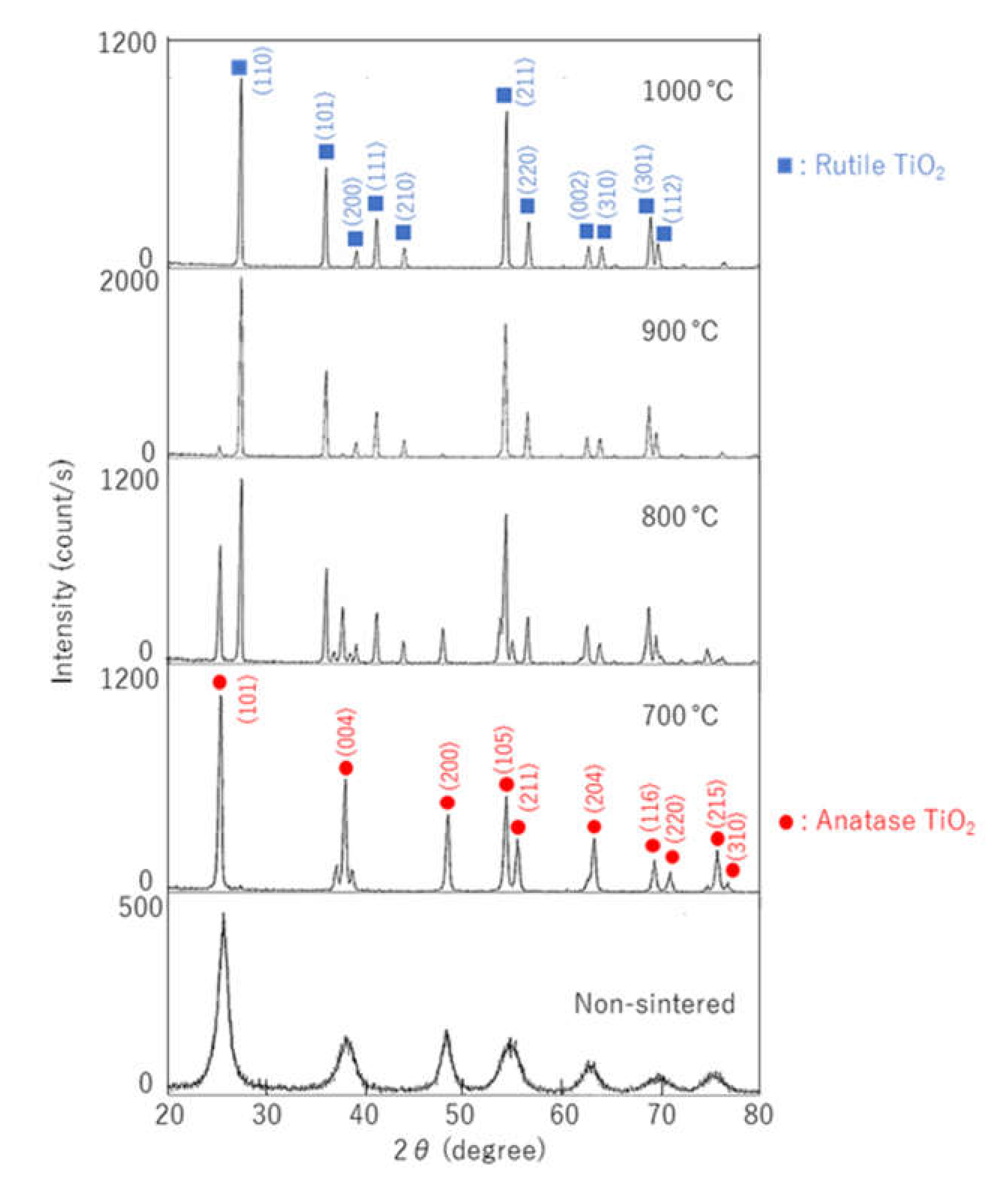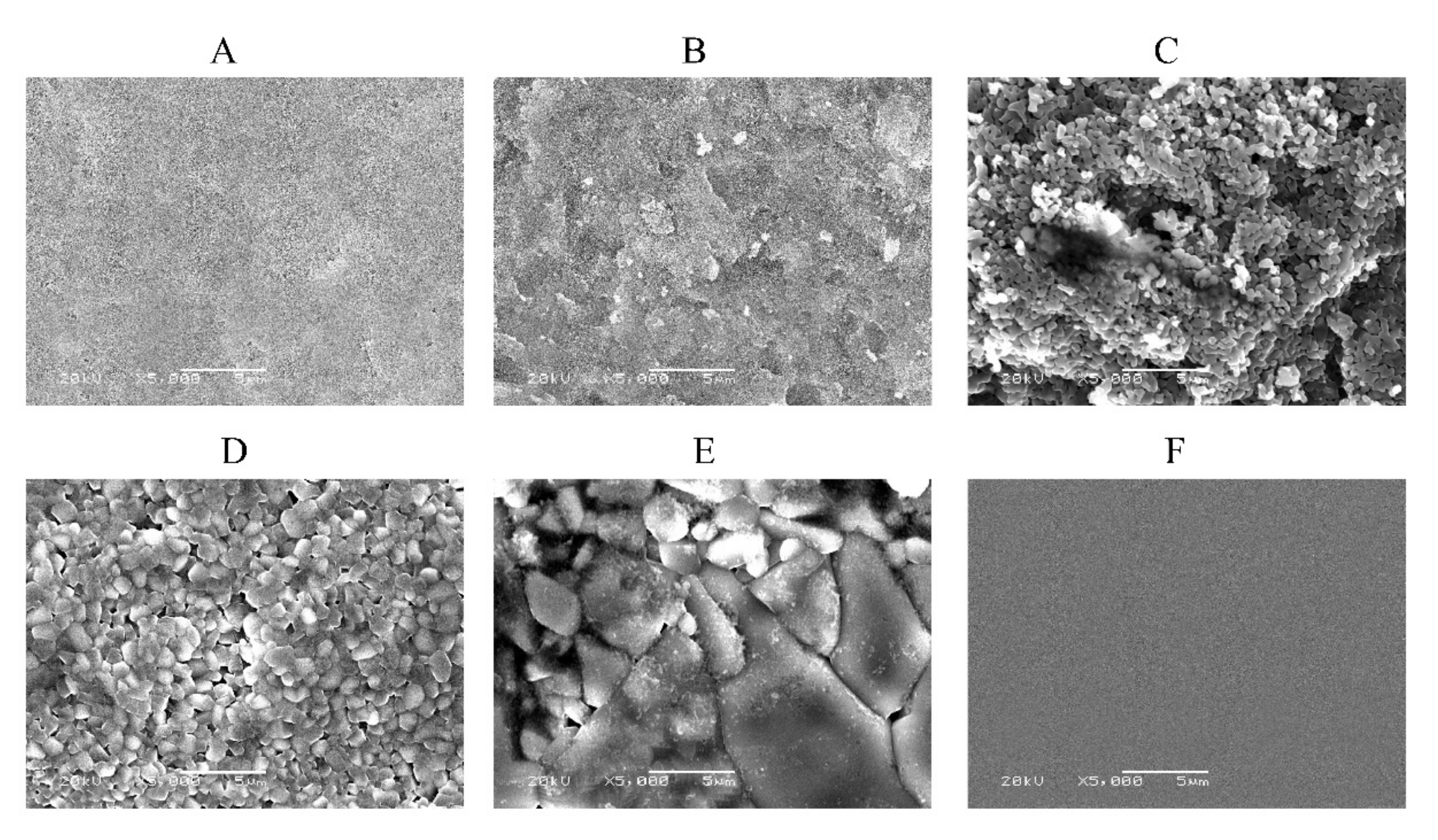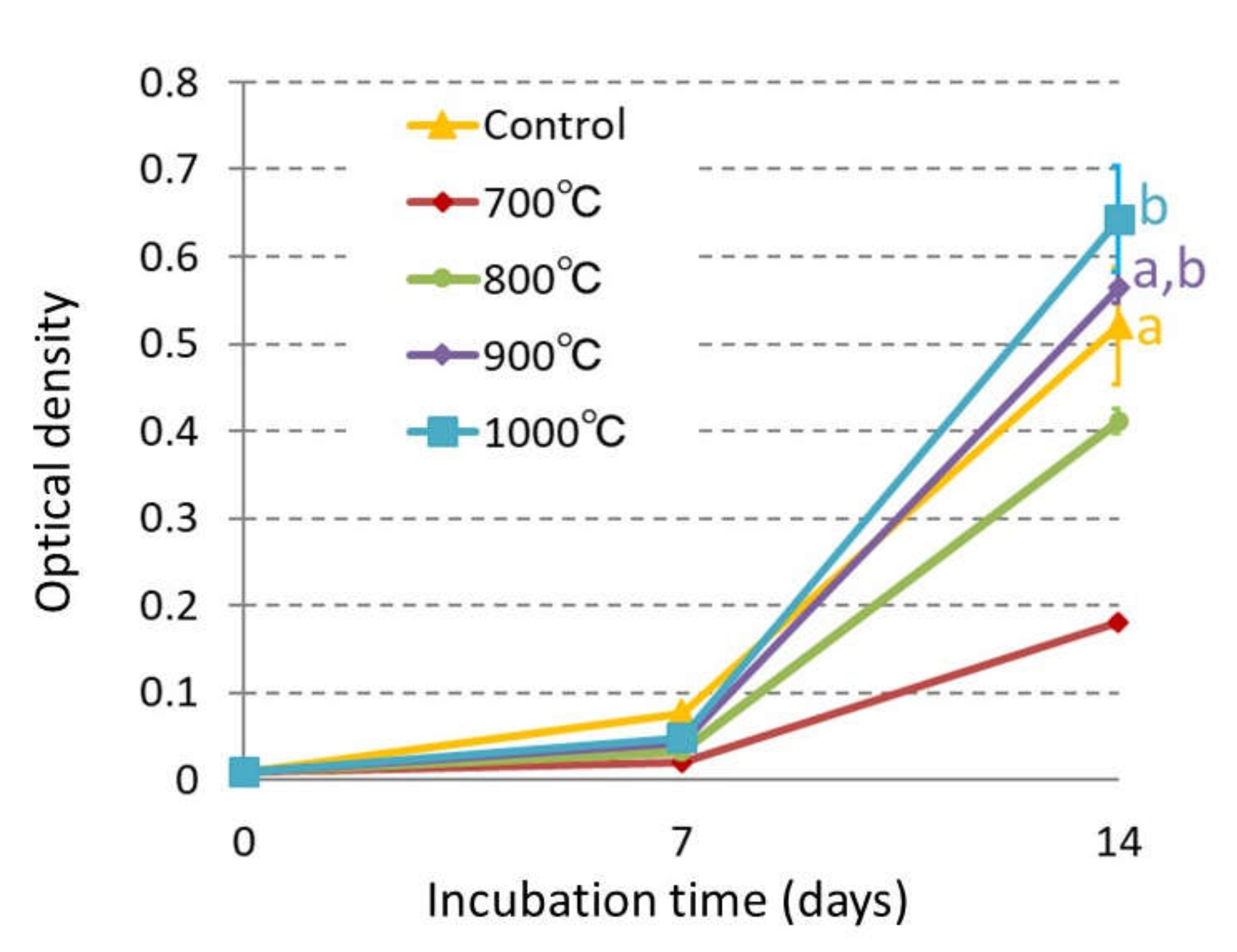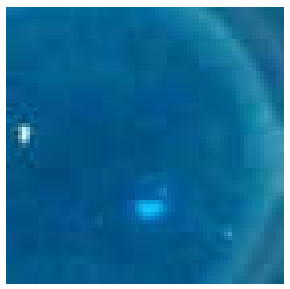Osteoblast-like Cell Proliferation, ALP Activity and Photocatalytic Activity on Sintered Anatase and Rutile Titanium Dioxide
Abstract
1. Introduction
2. Materials and Methods
2.1. Sample Preparation
2.2. X-ray Diffraction of TiO2 Sintered Body
2.3. Surface Observation of TiO2 Sintered Body
2.4. Cell Growth on TiO2 Sintered Body
2.5. Cell Morphology Observation
2.6. Photocatalytic Activity
2.7. Statistical Processing
3. Results
3.1. Identification of Crystal Phase
3.2. Surface Observation
3.3. Cell Growth and Alkaline Phosphatase Activity
3.4. Cell Morphology Observation
3.5. Photodegradation of Methylene Blue
4. Discussion
4.1. Application of Titanium Dioxide to Biomaterials
4.2. Mold Ability, Sintering, and Surface Characteristics of Titanium Dioxide
4.3. Change in ALP Activity and Photocatalytic Activity with Sintering Temperature
4.4. Evaluation of Titanium Dioxide Sintered Body as a Biomaterial
5. Conclusions
Funding
Institutional Review Board Statement
Informed Consent Statement
Data Availability Statement
Conflicts of Interest
References
- Itakura, Y.; Kosugai, A.; Sudou, H.; Yamamoto, S.; Kumegawa, M. Development of a new system for evaluating the biocompatibility of implant materials using an osteogenic cell line (MC3T3-E1). J. Biomed. Mater. Res. 1988, 22, 13–622. [Google Scholar] [CrossRef] [PubMed]
- Vrouwenvelder, W.C.A.; Groot, C.G.; Groot, K. Histological and biochemical evaluation of osteoblasts cultured on bioactive glass, hydroxyapatite, titanium alloy and stainless steel. J. Biomed. Mater. Res. 1993, 27, 465–475. [Google Scholar] [CrossRef] [PubMed]
- Marchi, J.; Ussui, V.; Delfino, C.S.; Bressiani, A.H.; Marques, M.M. Analysis in vitro of the cytotoxicity of potential implant materials. Zirconia-titania sintered ceramics. Materials 2016, 9, 619. [Google Scholar] [CrossRef]
- Blanca, C.; Francisco, L.; Rosario, V.; Julián, H.; Leandro, G.; Emilio, S.; Agustín, H.L.; Enrique, S. Cytotoxicity Evaluation of Anatase and Rutile TiO2 Thin Films on CHO-K1 Cells in Vitro. Materials 2016, 9, 619. [Google Scholar]
- Yokoi, Y.; Uozumi, T.; Matsuda, S.; Imanishi, T.; Toriya, J.; Shoumura, M.; Okafuji, N.; Osuga, N. Proliferation and Alkaline Phosphatase Activity of Osteoblast-like Cells on the Sintered Rutile Titanium Dioxide. J. Hard Tissue Biol. 2017, 26, 37–42. [Google Scholar] [CrossRef][Green Version]
- Wangab, K.; Zhuoa, Y.; Chena, J.; Gaoa, D.; Renb, Y.; Wangab, C.; Qi, Z. Crystalline phase regulation of anatase–rutile TiO2 for the enhancement of photocatalytic activity. RSC Adv. 2020, 10, 43592–43598. [Google Scholar] [CrossRef]
- Sangeetha, S.; Kathyayini, S.R.; Dhivya, P.; Sridharan, M. Biocompatibility studies on TiO2 coated Ti surface. In Proceedings of the 2013 International Conference on Advanced Nanomaterials and Emerging Engineering Technologies (ICANMEET 2013), Chennai, India, 24–26 July 2013. [Google Scholar]
- Zhao, L.; Chang, J.; Zhai, W. Effect of crystallographic phases of TiO2 on Hepatocyte Attachment Proliferation and Morphology. J. Biomater. Appl. 2005, 19, 237–252. [Google Scholar] [CrossRef]
- Brors, D.; Aletsee, C.; Schwager, K.; Mlynski, R.; Hansen, S.; Schäfers, M.; Ryan, A.F.; Dazert, S. Interaction of spiral ganglion neuron processes with alloplastic materials in vitro. Hear. Res. 2002, 167, 110–121. [Google Scholar] [CrossRef]
- Vila, M.C.; Buriel, B.M.; Chinarro, E.; Jurado, J.R.; Pastor, N.C.; Castro, J.E.C. Titanium oxide as substrate for neural cell growth. J. Biomed. Mater. Res. A 2009, 90, 94–105. [Google Scholar] [CrossRef]
- Han, W.; Wang, Y.D.; Zheng, Y.F. In Vitro biocompatibility study of nano TiO2 materials. Adv. Mater. Res. 2008, 47–50, 1438–1441. [Google Scholar] [CrossRef]
- Buchloh, S.; Stieger, B.; Meier, P.J.; Gauckler, L. Hepatocyte performance on different crystallographic faces of rutile. Biomaterials 2003, 24, 2605–2610. [Google Scholar] [CrossRef]
- Nakazawa, K.; Lee, S.W.; Fukuda, J.; Yang, D.H.; Kunitake, T. Hepatocyte spheroid formation on a titanium dioxide gel Surface and hepatocyte long-term culture. J. Mater. Sci. Mater. Med. 2006, 17, 359–364. [Google Scholar] [CrossRef]
- Suzuki, R.; Muyco, J.; McKitteick, J.; Frangos, J.A. A Reactive oxygen species inhibited by titanium oxide coatings. J. Biomed. Mater. Res. A 2003, 66, 396–402. [Google Scholar] [CrossRef]
- Anselme, K. Osteoblast adhesion on biomaterials. Biomaterials 2000, 21, 667–681. [Google Scholar] [CrossRef]
- Webster, T.J.; Siegel, R.W.; Bizios, R. Osteoblat adhesion on nanophase ceramics. Biomaterials 1999, 20, 1221–1227. [Google Scholar] [CrossRef]
- Frandsen, C.J.; Noh, K.; Brammer, K.S.; Johmston, G.; Jin, S. Hybrid micro/nano-topography of a TiO2 nanotube- coated zirconia femoral knee implant promotesbone cell adhesion in vitro. Mater. Sci. Eng. C Mater. Biol. Appl. 2013, 33, 2752–2756. [Google Scholar] [CrossRef]
- Fujishima, A.; Rao, T.N.; Tryk, D.A. Titanium dioxide phtocatalysis. Mater. J. Photochem. Phtobiol. 2000, 1, 1–21. [Google Scholar] [CrossRef]
- Lin, H.; Xu, Z.; Wang, X.; Long, J.; Su, W.; Fu, X.; Lin, Q. Photocatalyic and antibacterial properties of medical-grade PVC material coated with TiO2 film. J. Biomed. Mater. Res. B Appl. Biomater. 2008, 87, 425–431. [Google Scholar] [CrossRef]
- Ramires, P.A.; Romito, A.; Cosention, F.; Milella, E. The influence of titania/hydroxyapatite composite coatings on in vitro osteoblasts behaviour. Biomaterials 2001, 22, 1467–1474. [Google Scholar] [CrossRef]
- Kim, H.K.; Jang, J.W.; Lee, C.H. Surface modification of implant materials and its effect on attachment and proliferation of bone cells. J. Mater. Sci. Mater. Med. 2004, 15, 825–830. [Google Scholar] [CrossRef]
- Zhang, Y.M.; Bataillon-Linez, P.; Huang, P.; Zhao, Y.M.; Han, Y.; Traisnel, M.; Xu, K.W.; Hildebrand, H.F. Surface analyses of micro-arc oxidized and hydrothermally treated titanium and effect on osteoblast behavior. J. Biomed. Mater. Res. A 2004, 68, 383–391. [Google Scholar] [CrossRef]
- Bodhak, S.; Bose, S.; Kinsel, W.C.; Bandyopsdhyay, A. Investigation of in vitro bone cell adhesion and proliferation on Ti using direct current stimulation. Mater. Sci. Eng. C Mater. Biol. Appl. Mater. 2012, 32, 2163–2168. [Google Scholar] [CrossRef]
- Chen, J. Osteoblast-like cell ingrowth, adhesion and proliferation on porous Ti6Al4V with particulate and fiber scaffolds. Mater. Sci. Eng. C 2010, 22, 647–656. [Google Scholar] [CrossRef]
- Yamamoto, A.; Honma, R.; Sumita, M.; Hanawa, T. Cytotoxicity evaluation of ceramic particles of different sizes and shapes. J. Biomed. Mater. Res. A 2004, 68, 244–256. [Google Scholar] [CrossRef]
- Takeshita, F.; Ayukawa, Y.; Iyama, S.; Murai, K.; Suetsugu, T. Long-term evaluation of bone-titanium interface in rat tibiae using light microscopy, and image processing. J. Biomed. Mater. Res. 1997, 37, 235–242. [Google Scholar] [CrossRef]
- Aita, H.; Hori, N.; Takeuchi, M.; Suzuki, T.; Yamada, M.; Anpo, M.; Ogawa, T. The effect of ultraviolet functionalization of titanium on integration with bone. Biomaterials 2009, 30, 1015–1025. [Google Scholar] [CrossRef]
- Han, Y.; Chen, D.; Sun, J.; Zhang, Y.; Xu, K. UV-enhanced bioactivity and cell response of micro-arc oxidized titanium coatings. Acta Biomater. 2008, 4, 1518–1529. [Google Scholar] [CrossRef]
- Sawase, T.; Jimbo, R.; Baba, K.; Shibata, Y.; Ikeda, T.; Atsuta, M. Photo-induced hydrophilicity enhanced hydrophilicity enhanced initial cell behavior. Clin. Oral. Implant. Res. 2008, 19, 491–496. [Google Scholar] [CrossRef]
- Hayashi, M.; Jimbo, R.; Lindh, L.; Sotres, J.; Sawase, T.; Mustafa, K.; Andersson, M.; Wennerberg, A. In Vitro characterization and osteoblast responses to nanostructured photocatalysis TiO2 coated surfaces. Acta Biomater. 2012, 8, 2411–2416. [Google Scholar] [CrossRef]
- Hirakawa, Y.; Jimbo, R.; Shibata, Y.; Watanabe, I.; Wennerberg, A.; Sawase, T. Accelerated bone formation on photo-induced hydrophilic titanium implants: An experimental studt in the dog mandible. Clin. Oral. Implant. Res. 2013, 24, 139–144. [Google Scholar] [CrossRef]
- Uchino, T.; Tokunaga, H.; Ando, M.; Utsumi, H. Quantitative determination of OH radical generation and its cytotoxicity induced by TiO2-UVA treatment. Toxicol. Vitro 2002, 16, 629–635. [Google Scholar] [CrossRef]





| Sintered Temperature | 700 °C | 800 °C | 900 °C | 1000 °C |
|---|---|---|---|---|
| Dye resolution | 73.3% | 72.4% | 60.9% | 29.1% |
| Degradation color of methylene blue solution |  |  |  |  |
Publisher’s Note: MDPI stays neutral with regard to jurisdictional claims in published maps and institutional affiliations. |
© 2021 by the author. Licensee MDPI, Basel, Switzerland. This article is an open access article distributed under the terms and conditions of the Creative Commons Attribution (CC BY) license (https://creativecommons.org/licenses/by/4.0/).
Share and Cite
Yokoi, Y. Osteoblast-like Cell Proliferation, ALP Activity and Photocatalytic Activity on Sintered Anatase and Rutile Titanium Dioxide. Materials 2021, 14, 4414. https://doi.org/10.3390/ma14164414
Yokoi Y. Osteoblast-like Cell Proliferation, ALP Activity and Photocatalytic Activity on Sintered Anatase and Rutile Titanium Dioxide. Materials. 2021; 14(16):4414. https://doi.org/10.3390/ma14164414
Chicago/Turabian StyleYokoi, Yukiko. 2021. "Osteoblast-like Cell Proliferation, ALP Activity and Photocatalytic Activity on Sintered Anatase and Rutile Titanium Dioxide" Materials 14, no. 16: 4414. https://doi.org/10.3390/ma14164414
APA StyleYokoi, Y. (2021). Osteoblast-like Cell Proliferation, ALP Activity and Photocatalytic Activity on Sintered Anatase and Rutile Titanium Dioxide. Materials, 14(16), 4414. https://doi.org/10.3390/ma14164414






